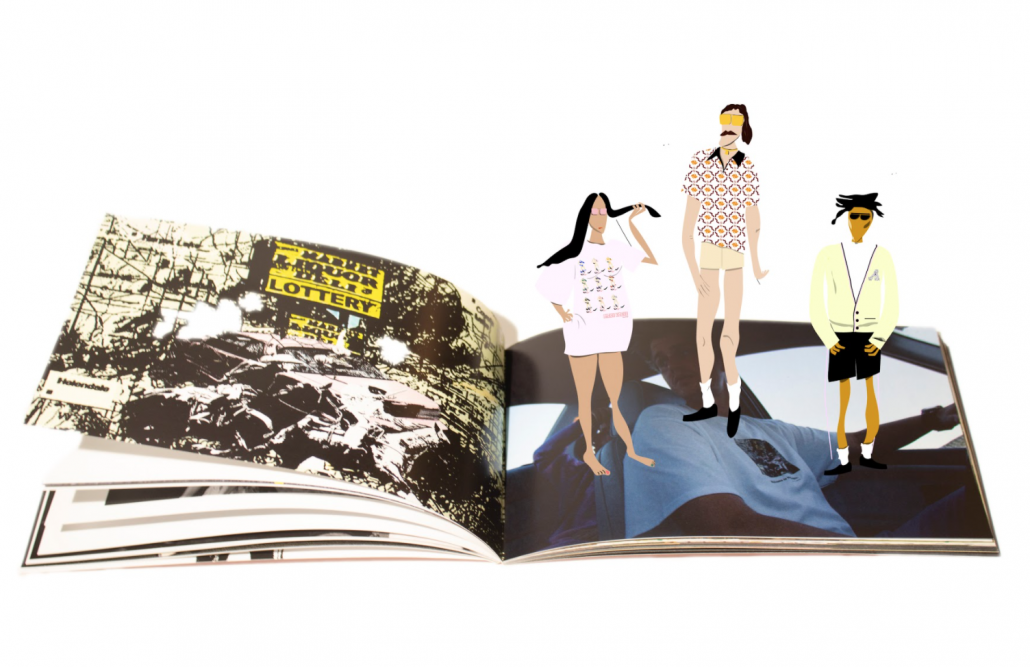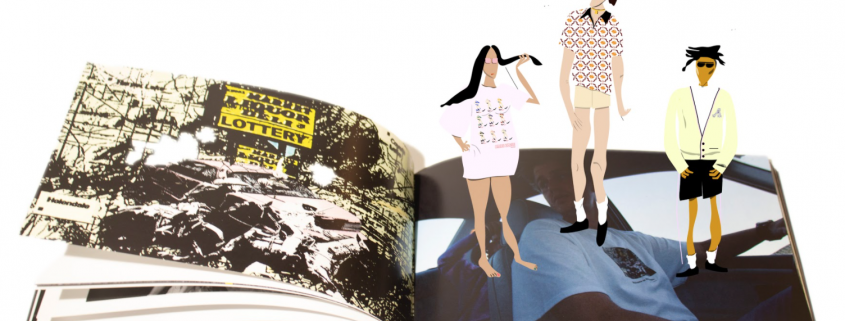Art Therapy: an exploration of emotion through fashion and film

To label Art Therapy as merely a clothing brand would be a grave misinterpretation of the project. John Lytle, a sophomore majoring in design, began Art Therapy in quarantine last spring as a way to tell stories through the clothing and film he made.
Between March and October 2020, Lytle designed and hand-sewed 13 original pieces, wrote and shot an original short film entitled “ART THERAPY vol. 1” that featured the clothes. Additionally, he created a comprehensive lookbook featuring the clothing collection. The project was almost entirely independent, besides working with collaborators on the film.
The idea for Art Therapy began before quarantine when Lytle took one of his drawings and sketched it as a print for a sweater. Although he was excited by the idea of making the sweater, the busyness of freshman year academics and social life didn’t lend much free time for other projects. But when the pandemic sent everyone home, Lytle found his opportunity.
“If quarantine never happened, I wouldn’t have been able to do it, so I kind of saw the moment and saw the time I had and thought I should just do it,” Lytle said.
The knitted sweater that began it all, aptly named “‘Art Therapy’ sweater,” appears at first glance to have an abstract pink and blue design, but upon closer inspection reveals the original drawing Lytle had created in ART-110. The image is of two people kissing in front of a landscape of rugged mountains. While it would be a sweet illustration, the girl’s eyes are wide open —– indicating tension in the relationship.
“I went through a really bad breakup freshman year … I wanted to talk about it but not directly talk about it,” Lytle said. And that is the point of Art Therapy: to talk about things.
“It mainly revolves around narrative; that’s the most important aspect of it, and just trying to find interesting ways to tell stories … and make it as personal as I can, and do that through clothing,” Lytle said.
While Lytle’s interest in making clothing began in high school, the film element he brought into the creation of Art Therapy was something new to him. Once he wrote the script, Lytle reached out to his high school friend Cole Swanson and USC freshman Jonah Mazer and asked them to help with the film. Swanson, a student at New York University majoring in film and television production, co-directed the film with Lytle. Mazer, a USC film production major, worked as the director of photography.
“We were really on the same page,” Swanson said. “It was just good synergy, good energy on set always.”
The short film, which runs a little less than 14 minutes, showcases the students’ art and film abilities. Though the film features the clothing Lytle made, it’s nothing like an advertisement campaign; it’s a work of art itself.
Lytle pulled inspiration from films such as “Dazed and Confused” and “Once Upon a Time in Hollywood,” both of which complement the 1980s style of his clothing.
“I think ‘Once Upon a Time in Hollywood’ was a huge inspiration in terms of the pacing and what I wanted it to feel like,” Lytle said. “Kind of slow, not boring, but immersing you in a world.”
After drafting the script, Lytle, a Pasadena native, drove around California’s deserts looking for locations to shoot and landed at the town of Helendale. Located off Route 66, Helendale’s last census reports its population as 5,623.
“There’s this random lake in the middle of the desert and all these houses around it,” Lytle said about the town. “It was cool getting all those shots with the lake and also the desert and kind of rural aesthetic. It’s a weird place, it feels like this other world.”
That eeriness is seeped into the plot of the film, as well. The story follows a struggling actor who, the film reveals halfway through, sexually assaulted multiple girls while in Hollywood. The film grows more abstract around the eight-minute mark, eventually crescendoing to a scene of hallucinatory violence.
The decision to make an antihero film was rooted in the same breakup that inspired the first drawing Lytle made for Art Therapy.
“[The film] does make you look yourself in the face and be like, ‘You [messed] up,’ and that’s what kind of led back to the relationship … looking back in ways I [messed] up and how it happened,” Lytle said. “Doing that through the trope of this failed actor felt like the best way to do it.”
Though this was the first screenplay Lytle wrote, the collaborators had minimal edits upon reading the initial draft. When Lytle first sent Swanson the script, he was taken aback by Lytle’s ability to write.
“I was like ‘Wow, this is better than a lot of the stuff my peers write back at film school,’” Swanson said. “I wasn’t surprised, but it was cool to see that side of his brain at work. He’s a very creative individual, really a visionary in his own respect.”
Along with this being his first film, Art Therapy was also Lytle’s first time designing and crafting a multiple-piece collection of clothing. Selin Aydin, a sophomore majoring in fine arts, was similarly surprised by seeing his new talents emerge last summer.
“He’s like a Renaissance man of sorts with photography, clothing, film, he does [graphic] design,” Aydin said. “It’s really cool to see his range.”
As fellow Roski students, Aydin and Lytle have found that their personal art styles mesh well together, and Aydin collaborated with Lytle on the “Mammoth Suit” by painting a mountain onto the garment, expertly playing with perspective and the physical composition of the garment itself.
Other than Aydin’s contribution, Lytle designed and sewed all the clothes himself, working consistent eight-hour days throughout the summer. Michelle Lytle, Lytle’s mother, watched him work daily at their dining table and attested to his work ethic.
“He’s kind of a rare combination where he seems like he’s talented, but he’s also a really hard worker and smart and figures it out and he’s organized, so he’s not just some crazy artist,” Michelle Lytle said.
As a hard worker, Lytle has already started working on the next installment of Art Therapy for this summer. He is currently planning to hold an in-person, outdoors fashion show in late August and is calling the next collection Art Therapy 1.5.
Art Therapy 1.5 will be much more abstract, with inspiration pulled from designers like Jean Paul Gaultier. Lytle is also looking to incorporate sustainability into the collection in creative ways.
“It’s still going to be in that kind of psychedelic, kind of crazy, experimental style from the first movie and the clothing of the first film, but kind of take it up a notch and make it … a lot more experimentation, not as streetwear inspired. More high fashion,” Lytle said.
While there won’t be an accompanying film for Art Therapy 1.5, Lytle plans on creating another narrative-driven collection in the future.
When asked if he’d like to work with Lytle on a film again, Swanson explained that though he rarely directs other people’s screenplays, he’d be happy to do another film for Art Therapy.
“He had a vision; I think that part of the reason I was so down to do it is because he really believed in the project and that was kind of enough for me to come on board, to see his passion for it,” Swanson said. “It’s very rare to see people really dedicated and committed to their craft.”

